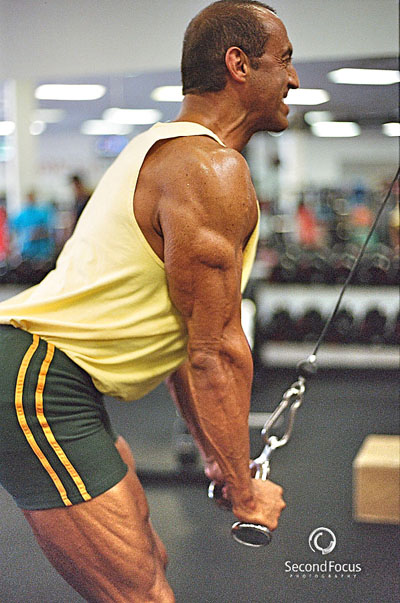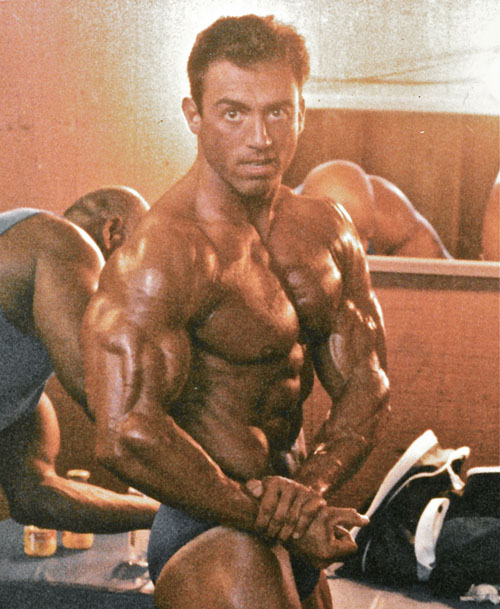You’ve probably noticed that “Triceps Pushdowns” – a common cable exercise for the back of the arms – can be done in a variety of ways. Aside from the fact that there are a number of possible handles one can use, including a single or double rope, we see people in the gym using all sorts of different methods.
Some people stand very close to the pulley – so close, in fact, that the cable runs alongside their head during the exercise. These people tend to use a lot of weight, and typically hold their elbows out to the sides, simulating what might seem like a kind-of “decline press for the chest”.
Others stand a little farther away from the cable, thereby allowing it to stay in front of them, but still very close to the head as the handle is pressed down.
Still others stand fairly far back – about two feet away from the machine. Some use a “reverse grip”, with the palms facing upward.
You might be asking if some versions are “right” while others are “wrong”, or whether these different methods somehow effect the triceps muscle differently. Do these variations change the shape of the triceps in any way? Some people think they do. We’ll discuss these variations of form in a minute, but let’s look at the triceps’ anatomy first.
Triceps & Elbow Anatomy
What it is that the triceps does? Namely, it’s function is to extend the elbow. The elbow joint is very much like a hinge – it bends one way. If you pick up a store-bought hinge – the kind you might use for a cabinet door – and examine its function, you’d see that it opens straight and closes straight – period. This is exactly what the elbow does.
All three heads of the TRI-ceps cross the elbow joint. Therefore, all three parts of the triceps participate in elbow extension. One part of the triceps also crosses the shoulder joint, so this particular head of the triceps also assists in the “adduction” of the humerus (bringing the upper arm bone down and toward you). This means that it becomes somewhat activated (participates to a very small degree) during pulldowns and rows. More specifically, however, this particular part of the triceps is the part we feel stretch, when we do an overhead triceps extension. Since its origin is on the underside of the shoulder, putting our arms overhead naturally causes this part of the triceps (known as the “long head”) to elongate more, during overhead triceps extensions. This extra elongation (stretch) likely provides some added stimulation to the long head of the triceps.
Shaping the Triceps?
Aside from the likelihood that the long head of the triceps becomes more activated by doing overhead triceps extensions, it’s impossible to preferentially activate the inner or outer heads of the triceps. Regardless of the exercise, and regardless of the hand position, all three heads of the triceps are activated when ANY triceps exercise is performed.
Since the elbow only bends and unbends straight, it’s anatomically impossible to cause one’s elbow to bend a little to the right, or a little to the left. If that were (theoretically) possible, one could argue that a particular portion of the triceps pulls to the left, while another portion pulls to the right. But that’s not reality. Since the elbow only bends and unbends straight, it’s impossible to affect one part of the triceps more than another part of it (i.e., inner head vs. outer head). All three heads of the triceps participate in elbow extension, simultaneously.
We’ve all seen individuals who have a particularly outstanding “outer triceps”, and we often make the assumption that that individual has done something special to cause that development. That would be a mistaken assumption.
Ironically enough, if that individual does ANYTHING unusual during his triceps workout, we’re quick to assume that THAT must be the secret to his outer triceps development. But it’s genetics that determines the shape of a muscle. We can certainly influence its size. But in the nearly 40 years that I’ve been involved in bodybuilding, I’ve never seen anyone change the shape of any particular muscle. Whatever the size of the muscle throughout its various stages of development, its shape has been the same since before that person started training.
Pushdowns Form
Ideally, during a triceps workout, our goal is usually to maximally stimulate the triceps muscle, thereby inducing growth. The factors involved in “maximum stimulation” include intensity (weight used, reps and fatigue), volume (number of sets), recovery (frequency of workouts and nutrition), and exercise form.
This particular article is only about exercise form, because it is a subject that stands alone, and we are limited in time and space. The other three factors – intensity, volume and recovery are separate subjects, each worthy of their own article. So we’ll focus ONLY on triceps exercise form here. But the other three factors are also important.
Exercise form for any exercise is determined by several bio-mechanical principles. There must be proper alignment between the levers involved, the target muscle, and the direction of the resistance. There should also be a safe and productive “resistance curve”. This means that, while a muscle is moving its appropriate limb through its normal range of motion (e.g., the triceps moving the forearm), the variations of resistance throughout the range of motion should be consistent with that muscle’s capabilities.
The rules of physics (as they pertain to levers) dictate that whenever a lever (in this case, the forearm) is perpendicular to resistance, the muscle acting upon that lever (in this case, the triceps) encounters maximum resistance. Conversely, whenever a lever is parallel to resistance, the muscle acting upon that lever encounters minimal resistance.
During a Triceps Pushdown, the cable indicates the direction of resistance. The forearm, as the lever that is being acted upon by the triceps, would cause the triceps to encounter maximum resistance when it (the forearm) is perpendicular to the cable. Conversely, when the forearm is parallel to the cable, the triceps to encounters the least amount of resistance.
So, if one stands very close to the pulley when doing a Triceps Pushdown, one is likely to experience more resistance at the beginning of the movement (when the elbow is fully bent), and less resistance at the conclusion of the movement (when the elbow is straight, and therefore parallel to the cable). If a person stands farther away from the pulley, that person would encounter less resistance at the beginning of the movement, and more at the conclusion of the movement. The question you might be asking now is, “which one is better?”.
They’re both good, although I believe standing a bit farther away from the pulley is a bit better, because it allows the point of contraction to occur WITH some opposing resistance. It also tends to allow better alignment between the upper arms, forearms, triceps and cable. Standing too close to the pulley causes one’s elbows to move outward, thereby causing the pectorals to assist. It also tends to minimize the resistance the triceps encounters at the point of contraction (the lock out).
Using a “palms up” grip is often used with the (mistaken) belief that it affects the triceps differently. This is more folklore than science. The elbow bends and straightens the exact same way in both cases. The triceps has no idea what the hand is doing, and it (the triceps) doesn’t “care”. It’s job is to extend the elbow – period. The triceps are not connected to the hand, so it doesn’t know, nor care, whether you’re using a rope, a V-handle, or a reverse grip on a straight handle. It (the triceps) is extending the elbow in the exact same way, regardless of the grip.
So the only two things that matter to the triceps are the “resistance curve” (i.e., where it finds more or less resistance throughout the range of motion), and (only in the case of the long head of the triceps) whether the arms are positioned overhead, angled downward toward the feet, or angled straight out – perpendicular to the body.
For best results, use exercises that provide a productive resistance curve (i.e., where maximum resistance is encountered midway through the range of motion), and try to include at least one triceps exercise that is “overhead” (assuming your shoulders are healthy, and are not bothered by that position).
An example of an exercise that fails to provide a productive resistance curve is “Bench Dips” or “Parallel Bar Dips”, because – in both cases – the forearm NEVER crosses resistance (i.e., the forearm is never perpendicular to gravity). These two exercises stress the front deltoids FAR more than the triceps (because it’s the upper arm that crosses gravity). Another exercise that has a compromised resistance curve is the Triceps Kickbacks (with dumbbell). It fails to provide any resistance at all, during the first part of the triceps’ range of motion (from the elbow being most bent, until it reaches 90 degrees), then provides too much resistance at the point of contraction – so much so, that one is unable to fully contract the triceps, unless the weight is very light.
My favorite triceps exercises are Cable Pushdowns, Overhead Cable Extensions and Supine (flat bench) Extensions with dumbbells. They provide an excellent resistance curve, and cover the three primary shoulder angles.

The author, in 2011, performing Triceps Pushdowns (photo by Ian Sitren). Notice how standing back away from the pulley, allows the triceps to contract against some degree of resistance (due to the angle between the cable and the forearm).

Doug Brignole, backstage at the 1991 Northwestern Mr. America




















You must be logged in to post a comment Login